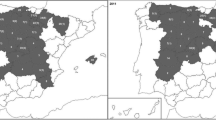Abstract
The presence of Ascosphaera apis, a fungus that is the causative agent of chalkbrood disease, was surveyed in Japan using a diagnostic polymerase chain reaction (PCR). A total of 336 individual European honeybees Apis mellifera were taken from 25 different apiaries in various regions of Japan. Of the 112 colonies surveyed, A. apis was detected in 27 colonies (24.1%). Positive results by PCR were obtained from 49 out of 336 surveyed individuals (14.6%). Based on these results, the distribution of A. apis in A. mellifera is widespread across Japan and does not exhibit significant differences between geographic areas. DNA sequences of the ITS and 5.8S rRNA region from all 17 isolates of A. apis were identical, even though they were from geographically distinct areas in Japan. It is suggested that no intra-species variation may be due to a recent bottleneck effect probably caused by humans before geographical expansion of the fungus.



Similar content being viewed by others
References
Anderson DL, Gibbs AJ, Gibson NL (1998) Identification and phylogeny of spore-cyst fungi (Ascsphaera spp.) using ribosomal DNA sequences. Mycol Res 102:541–547
Aronstein KA, Murray KD (2010) Chalkbrood disease in honey bees. J Invertebr Pathol 103:S20–S29
Aronstein KA, Murray KD, de Leon JH, Qin X, Weinstock GM (2007) High mobility group (HMG-box) genes in the honey bee fungal pathogen Ascosphaera apis. Mycologia 99:553–561
Borum AE, Ulgen M (2008) Chalkbrood (Ascosphaera apis) infection and fungal agents of honey bees in north-west Turkey. J Apic Res 47:170–171
Flores JM, Ruiz JA, Ruz JM, Puerta F, Bustos M, Padilla F, Campano F (1996) Effect of temperature and humidity of sealed brood on chalkbrood development under controlled conditions. Apidologie 27:185–192
Flores JM, Spivak M, Gutiérrez I (2005) Spores of Ascosphaera apis contained in wax foundation can infect honeybee brood. Vet Microbiol 108:141–144
Genersch E, Forsgren E, Pentikäinen J, Ashiralieva A, Rauch S, Kilwinski J, Fries I (2006) Reclassification of Paenibacillus larvae subsp Pulvifaciens and Paenibacillus larvrae subsp. larvae as Paenibacillus larvae without subspecies differentiation. Int J Syst Evol Microbiol 56:501–511
Gilliam M, Vandenberg JD (1997) Fungi. In: Morse RA, Nowogrodzki R (eds) Honey bee pests predators and diseases. Cornell University Press, Ithaca, NY, pp 80–110
James RR, Skinner JS (2005) PCR diagnostic methods for Ascosphaera infections in bees. J Invertebr Pathol 90:98–103
Jensen AB, James RR, Eilenberg J (2009) Long-term storage of Ascosphaera aggregata and A apis, pathogens of the leafcutting bee (Megachile rotundata) and the honey bee (Apis mellifera). J Invertebr Pathol 101:157–160
Katayama E (1987) Utilization of honeybees as pollinators for strawberries in plastic greenhouses. Honeybee Sci 8:147–150 (in Japanese)
Lauro FM, Favaretto M, Covolo L, Rassu M, Bertoloni G (2003) Rapid detection of Paenibacillus larvae from honey and hive samples with a novel nested PCR protocol. Int J Food Microbiol 81:195–201
Lindstrom A, Fries I (2005) Sampling of adult bees for detection of American foulbrood (Paenibacillus larvae subsp larvae) spores in honey bee (Apis mellifra). J Apic Res 44:82–86
Ohishi T (1999) Appropriate management of honeybee colonies for strawberry pollination. Honeybee Sci 20:9–16 (in Japanese)
Piccini C, D’Alessandro B, Antunez K, Zunino P (2002) Detection of Paenibacillus larvae subspecies larvae spores in naturally infected bee larvae and artificially contaminated honey by PCR. World J Microbiol Biotechnol 18:761–765
Rust R, Torchio P (1992) Effects of temperature and host developmental stage on Ascosphaera torchioi Youssef and McManus prevalence in Osmia lignaria propinqua Cresson (Hymenoptera: Megachilidae). Apidologie 23:1–9
Schuch DMT, Madden RH, Sattler A (2001) An improved method for the detection and presumptive identification of Paenibacillus larvae subsp larvae spores in honey. J Apic Res 40:59–64
Spiltoir CF, Olive LS (1955) A reclassification of the genus Pericystis betts. Mycologia 47:238–244
Wood M (1998) Microbes help bees battle chalkbrood. J Econ Entomol 46:16–17
Zaghloul OA, Mourad AK, El Kady MB, Nemat FM, Morsy ME (2005) Assessment of losses in honey yield due to the chalkbrood disease, with reference to the determination of its economic injury levels in Egypt. Commun Agric Appl Biol Sci 70:703–714
Acknowledgments
The authors are grateful to Ms. Noriko Takaya and Kyoko Iwata for their technical assistance. We also wish to thank Dr. Luke Jacobus for his valuable comments on the manuscript.
Author information
Authors and Affiliations
Corresponding author
Rights and permissions
About this article
Cite this article
Yoshiyama, M., Kimura, K. Presence of Ascosphaera apis, the causative agent of chalkbrood disease, in honeybees Apis mellifera (Hymenoptera: Apidae) in Japan. Appl Entomol Zool 46, 31–36 (2011). https://doi.org/10.1007/s13355-010-0008-8
Received:
Accepted:
Published:
Issue Date:
DOI: https://doi.org/10.1007/s13355-010-0008-8



